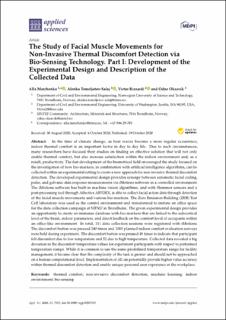| dc.contributor.author | Marchenko, Alla | |
| dc.contributor.author | Temeljotov Salaj, Alenka | |
| dc.contributor.author | Rizzardi, Victor | |
| dc.contributor.author | Oksavik, Odne Andreas | |
| dc.date.accessioned | 2020-10-20T06:35:20Z | |
| dc.date.available | 2020-10-20T06:35:20Z | |
| dc.date.created | 2020-10-19T15:57:28Z | |
| dc.date.issued | 2020 | |
| dc.identifier.citation | Applied Sciences. 2020, 10(20) . | en_US |
| dc.identifier.issn | 2076-3417 | |
| dc.identifier.uri | https://hdl.handle.net/11250/2683752 | |
| dc.description.abstract | In the time of climate change, as heat waves become a more regular occurrence, indoor thermal comfort is an important factor in day to day life. Due to such circumstances, many researchers have focused their studies on finding an effective solution that will not only enable thermal comfort, but also increase satisfaction within the indoor environment and, as a result, productivity. The fast development of the biometrical field encouraged the study focused on the investigation of how bio-markers, in combination with artificial intelligence algorithms, can be collected within an experimental setting to create a new approach for non-invasive thermal discomfort detection. The developed experimental design provides synergy between automatic facial coding, pulse, and galvanic skin response measurements via iMotions software in a controlled environment. The iMotions software has built-in machine vision algorithms, and with Shimmer sensors and a post-processing tool through Affectiva AFFDEX, is able to collect facial action data through detection of the facial muscle movements and various bio-markers. The Zero Emission Building (ZEB) Test Cell laboratory was used as the control environment and transformed to imitate an office space for the data collection campaign at NTNU in Trondheim. The given experimental design provides an opportunity to create an immense database with bio-markers that are linked to the subcortical level of the brain, indoor parameters, and direct feedback on the comfort level of occupants within an office-like environment. In total, 111 data collection sessions were registered with iMotions. The discomfort button was pressed 240 times and 1080 planned indoor comfort evaluation surveys were held during experiment. The discomfort button was pressed 49 times to indicate that participant felt discomfort due to low temperature and 52 due to high temperature. Collected data revealed a big deviation in the discomfort temperature values for experiment participants with respect to performed temperature ramps. While it is common to use the same predefined temperature range for facility management, it became clear that the complexity of the task is greater and should not be approached on a human computational level. Implementation of AI can potentially provide higher value accuracy within thermal discomfort detection and enable unique personal user experience at the workplace. | en_US |
| dc.language.iso | eng | en_US |
| dc.publisher | MDPI | en_US |
| dc.rights | Attribution-NonCommercial-NoDerivatives 4.0 Internasjonal | * |
| dc.rights.uri | http://creativecommons.org/licenses/by-nc-nd/4.0/deed.no | * |
| dc.title | The Study of Facial Muscle Movements for Non-Invasive Thermal Discomfort Detection via Bio-Sensing Technology. Part I: Development of the Experimental Design and Description of the Collected Data | en_US |
| dc.type | Peer reviewed | en_US |
| dc.type | Journal article | en_US |
| dc.description.version | publishedVersion | en_US |
| dc.source.pagenumber | 27 | en_US |
| dc.source.volume | 10(20) | en_US |
| dc.source.journal | Applied Sciences | en_US |
| dc.identifier.doi | 10.3390/app10207315 | |
| dc.identifier.cristin | 1840623 | |
| dc.description.localcode | © 2020 by the authors. Licensee MDPI, Basel, Switzerland. This article is an open access article distributed under the terms and conditions of the Creative Commons Attribution (CC BY) license (http://creativecommons.org/licenses/by/4.0/). | en_US |
| cristin.ispublished | true | |
| cristin.fulltext | original | |
| cristin.qualitycode | 1 | |

